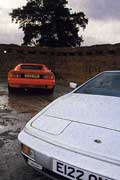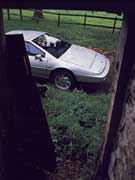
Motor Magazine 1987 - Lotus Esprit Turbo

By most manufacturers' standards, in replacing the Series 3, it ought at least to be labelled Series 4. Some other car makers would certainly label a revamp which involved an entirely new body as a brand-new car. Group Lotus Chief Executive Michael Kimberley takes a view that is both modest yet long-ranging, calling the two-model 1988 Lotus Esprit merely a 'stepping stone to the coming new range'. Launched this week, the biggest revision of Lotus' mid-engined two-seater coupé in its 12-year life centres round that new body, which in place of the very crisp Giugiaro folded-paper-style original is a wholly in-house Lotus job, the work of a new styling division of Lotus Engineering headed by design director Colin Spooner. It also introduces a manufacturing technique new to the previously hand-laid-up Esprit body, Lotus' vacuum-assisted resin injection (VARI) method, first used on the Excel, which is the key to a much greater planned rate. The production figures Lotus promise themselves for the year from September just passed make interesting reading; total planned output is 1206, a 40.9 per cent gain on the year before's 856. That will be made up of 25 per cent front-engine and 75 per cent mid-engine, reminding one how important the specialised and exotic Esprit is against the distinctly more practical Excel. This also betrays the present North American concentration on the two-seater and the fact that half the Esprit production will be American specification cars – and why the launch today in simultaneous, one here at Motorfair, one in Florida.

Under the new skin, the car is at first sight unchanged. The hot-dip galvanised backbone chassis continues, but the most obvious difference is at the back, where the solid disc brakes go conventional, moving outboard on to new suspension uprights; this spoils the sprung-to-unsprung weight ratio – supposedly important in a still fairly light (for its class) car – but makes brake cooling much easier. Outboard brakes are forced on the Esprit by the substitution in European market cars of the transaxle from the Renault Alpine GTA for the previous Citroën SM gearbox. One might have thought that availability of the SM box (which dates back to a car last sold shortly after the first Esprit appeared) was the reason for the change, but it continues to be used in the American market car, mainly to reduce the appalling costs of re-certification. To illustrate this, Michael Kimberley points to the carried over, somewhat old-fashioned mouse-trap outside door handles, whose now somewhat clumsy bulk doesn't blend with the new-found smoothness of the body. Door locks are safety-quango sensitive items; a new lock on a new door beam would add a quarter-million (sterling) to the re-certifying bill. The old body was largely made up of two hand-laid glass-fibre reinforced (grp) upper and lower shell plastic mouldings. The VARI method, originally evolved by Lotus for the much larger mouldings needed for motor boats, makes it easier and faster to produce large one-piece grp parts of consistent integrity. As in a hand-laid job, the basic mould is female, to give the required high-quality outer surface. The first difference is that there is an inner male mould, controlling thickness and therefore strength and weight much better – and also giving an inner surface with the same standard of finish as the outer.
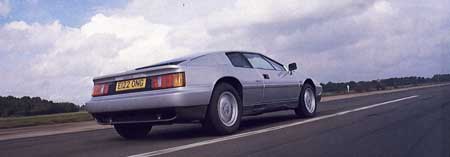
The process starts conventionally, with gel coat (pure resin, without any additions) and pieces of the reinforcing glass cloth, plus, in the case of the new Esprit's upper half, extra aramid foam beam (Kevlar) reinforcements in the A-pillars and all round the roof, hand-laid in the female mould. Then the male inner mould, which has a seal round its joint face, is bolted to the female. Vacuum is applied to the inner, drawing resin fed in at several points from above evenly into the whole mould cavity. In the case of the Esprit, as in the Excel, there have always effectively been two main mouldings, top and bottom of the shell. There is one considerable improvement, aesthetically and probably structurally, in the way the upper and lower shells are joined. In the older car, the joint face in horizontal, which its designers turned into a marked styling feature, making a very obvious rib along the body side. In the raw new Esprit assembly, the top shell's joint laps over the lower shell's, which after top and bottom have been bonded together is filled with resin and flushed off. There is still a rib, but much less heavy in size and look.
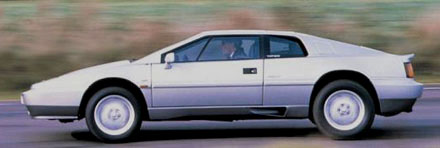
Such relative structural oneness, which can exceed the same virtue achieved in normal pressed steel body-chassis when the number of individual pressings is reduced, makes a considerably stiffer shell. That is no minor gain when what one might call the core chassis is, where it is most stressed, along its centre length (through the cockpit), a rectangular-section box beam, deep maybe but not nearly as wide, only widening to the T-like cross member in front, and the intrinsically stiff tubular cradle from rear bulkhead aft. To make a backbone chassis as torsionally stiff as the equivalent unitary steel shell of a conventional car, you need either a very heavy section backbone or to give it some help from the body. Since the body's weight is already there, it may as well be utilised. The Esprit always has used its basically two-piece body in this way; with the body bolted to the un-stiff chassis, the overall stiffness is nearly doubled to something acceptable, if not in the same class as many steel body production hatchbacks. The stiffer a 'chassis' (however it is formed), the better it forms an anvil against which the suspension can react, and the more faithfully will the wheels maintain the geometric motion intended by the suspension engineer. Apparently because of better panel design, the new body raises the overall stiffness further. The '88 Esprit is claimed to be a considerable improvement in this way, with what is said to be a noticeably better ride and handling. Apart from the difference in transmission and, for countries like our own which do not yet force US '83 emission standards on every car over 2-litres, the engine, all new Esprits use the same body specifications. In other words, the British and European buyer is sold the car in US Federal form as far as the bumpering and side intrusion crash protection are concerned. This was always so as far as the Esprit door beams were concerned, but not at front and rear. The new car comes standard therefore with 2.5mph RRIM integral bumpers and, thanks to that Kevlar-reinforced roof, exceptional roll-over crush resistance, deflecting only 1 inch in the US crush test against the permitted 5 in. So, although the new body follows the old within an inch throughout, and the Alpine gearbox is around 20lb less heavy than the Citroën one, the car – according to the maker's figures of 1268kg (2795lb) – is heavier by 196lb (7.5%), the weight being distributed 42.7/57.3 front/rear.
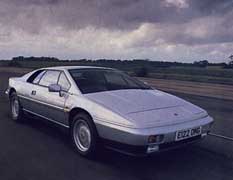
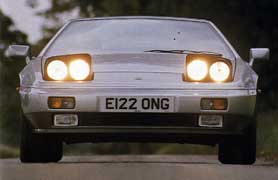
Thus it is interesting that in development, Lotus ended up with roughly the same spring rates and damper settings as in the old car, despite the extra mass. This added inertia does of course help counter that increase in unsprung weight at the back due to the outboard brakes. One cannot help suspecting that if the increase in chassis stiffness is as large as is implied, one could use the same springs as before because the necessary difference in overall spring rate is made up to some extent – in the right direction – by the difference in chassis stiffness. The smoother shell is no significant improvement aerodynamically, with the Cd figure of 0.34 for the Turbo and 0.35 for the normally aspirated Esprit. Usually, the more powerful car in any range has the worst drag because of bigger intakes and radiators, but the reason for the opposite difference here is more fundamental. As before, the roof behind the cockpit ends in two solid buttresses at each side, half enclosing a cavity in between. On the Turbo, this is largely roofed by a sheet of 5mm glass which continues the roof line nearly to rear deck level; it actually ends before, leaving a slot opening which Lotus uses as an engine bay hot-air extractor. The same glass is not used on the unblown Esprit. It is interesting that, originally, both cars were to share this glass back, and that the less powerful car was denied it for styling-cum-model identification motives. Mike Kimberley assures that there is no vision problem, although he concedes that in some circumstances – such as stopping in humid conditions after a hot, hard run – there is some misting, but that this clears after a minute or so once you drive off again, the door mirrors giving you the necessary rear view meanwhile. At first Lotus did incorporate heater filaments, removed because, as such a shallow angle, they obstructed more continuously than they occasionally had to clear.
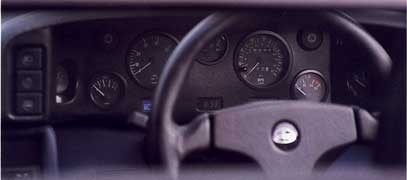
Our own experience with the very raked glass is that it is a nuisance in rain at very low speeds but, on such an aerodynamically clean part of the shape, it clears once you get moving at a reasonable pace. It is doubtful if any practical driver will mourn the disappearance of the previous car's rear window slats, a piece of entirely needless styling clutter. All Esprits come with a detachable/tilt roof panel, either opaque in aramid (Nomex) honeycomb, or optional tinted glass. To counter criticisms of undue wind noise, the door windows are new steel-framed and there are double seals for each door opening. Ventilation is said to be much better, with cabin air leaving more freely via the doors instead of out through rear extractors close to the occupants. It is said that cabin pressurising at speed noticed in the old car (and on plenty of other makers' machines) is considerably reduced. There are still two fuel fillers for the same size tankage (18.9 gallons for the Turbo, 14.8 for the other car), but their flaps are released only from inside, instead of with a key. Windscreens are more curved, and still bonded in place as structural members. Observers will question the triangular root to each A-pillar; this was originally meant to mount a specially designed triangular-form mirror, but none which gave legal rear view was found. Lotus expect, with the help of a Canadian supplier, to put this right in due course.
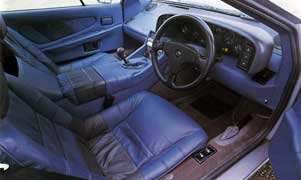
Although the door opening is no bigger than before (even though the doors themselves are new apart from those side-intrusion beams), there is more room inside, to the tune of 0.8 inch in headroom, 0.6 inch in legroom, and an inch more width in the footwells. Seats are an inch wider, with rake-adjustable backs, but this will only be of any use to the shorter driver, since anybody taller will have pushed the seat full back and run out of rake adjustment space against the bulkhead. Instruments are now supplied by VDO, with the turbo boost and oil pressure gauges working off electrical sensors instead of mechanical ones. Electrical details include a new Ristex lightweight cable loom, 36 instead of the previous car's eight fuses, and grouping of the control equipment into two places – body functions ahead of the front bulkhead, engine ones behind. There are new motors for the headlamp and window lifts. A new wiper mechanism replaces the cable drive with a mechanical linkage, and the screen wash has two single jet outlets. Warning lamps tell of low oil pressure, cooling fan failure, low screen wash, low oil level, no charge, and low fuel, and there is a lamp test arrangement. Binnacle switches are the push-push type. The header blower is claimed to be quieter. It may seem strange to turn to the engines so late in the description of a pair of very fast new cars, but that is because very little has happened to these two 95.3x76.2mm 2174cc dohc 16-valve aluminium-ally fours in the changes. On the Turbo, there is a new Garrett with integral wastegate and, more importantly, watercooling – very useful in guarding against the possibility, common to all turbos, of the bearing being ruined by heat soak in the hands of the inexperienced user who switches off too quickly after a long hard run. The exhaust system is now entirely stainless steel, and the cooling system uses a recuperative coolant system.
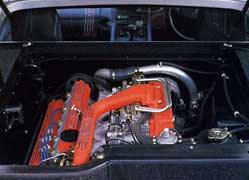
Power outputs are quoted as unchanged from previous HC models – 215bhp (DIN) at 6000rpm and 220lb ft at 4250rpm for the Turbo, and 172bhp at 6500 plus 163lb ft at 5000rpm for the normally aspirated car. On the same size tyres, the new transmission (common to both models) gives slightly higher gearing in all ratios except (by a tenth of 1mph) bottom. At first sight, remembering that extra weight, you might be puzzled by Lotus' claimed 0-60mph standing start figure of 5.3 seconds for the Turbo, which is 0.1 sec faster than Motor's road test time. This is probably explained by the slightly higher second gear, which puts 60mph not so far up beyond the maximum power engine speed. The 0-100mph time is given at an impressive sounding 14.7 sec. One can understand a higher maximum speed of 152mph for the Turbo. Corresponding figures for the less powerful Esprit are 0-60mph in 6.5 sec, 0-100 in 18.8 sec and 138mph (for which it is obviously overgeared) in top. Want to buy one or t'other? You'll have to find slightly more than 11% extra, since the Esprit is £22,950 and the Esprit Turbo £28,900 – plus, for any of the following options (Car Tax and VAT included):
